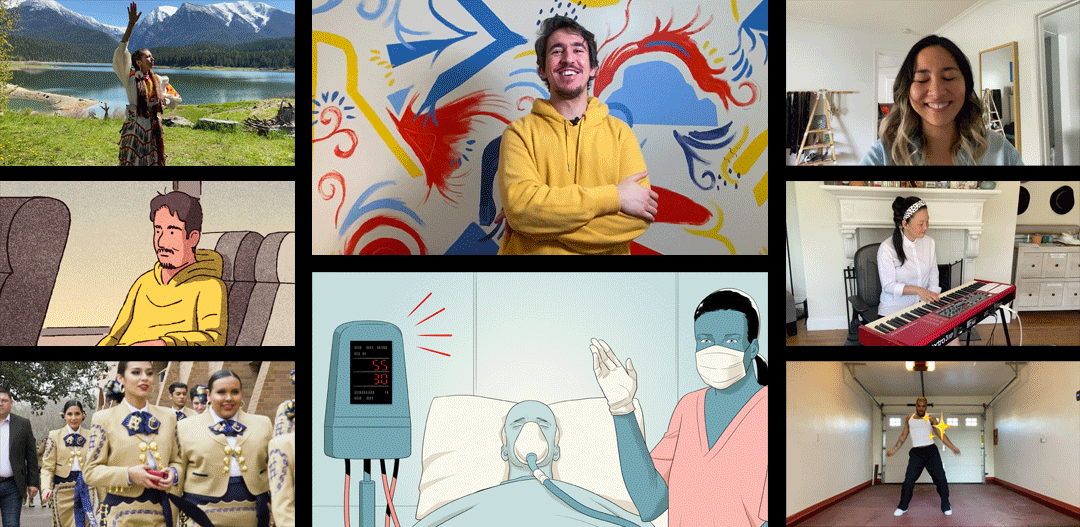A live magazine pops up in your home, wherever you are
For the past several years, Pop-Up Magazine has resurrected extinct flowers, analyzed dreams, ventured into the Darien Gap, rowed across the Atlantic Ocean and shared ancient songs from Istanbul's Hagia Sofia—all from the comfort of theaters throughout the United States. Three times a year, the "live magazine" hits the road, featuring storytelling performed onstage by journalists, filmmakers, comedians, photographers and musicians, selling out every venue along the way. At every show, the hosts tell the audience the same thing: "After tonight, the show will disappear. You won't find anything online. We made it just for you."
But in recent months, the team behind the experience has had to rethink what it means to go on tour—and how they might bring their offline show online. Last night, in collaboration with Google, Pop-Up Magazine debuted its first digital show on its YouTube channel, free of charge and available around the world. We caught up with Chas Edwards, Pop-Up Magazine's president and cofounder, to hear about how the team made such an extraordinary pivot.
What happened for your team when the world went on lockdown?
It was a little like telling your soccer team they'd made the Olympics, only they'd be competing in water polo. But the day after CDC guidelines changed our plans to go on tour, our producers filled up a 20-page Google Doc with ideas on how we could show up for our audience while sheltering in place. And because Pop-Up Magazine has always been multimedia—we've paired filmmakers with dancers, radio producers with opera singers, tech journalists with shadow puppets—we are highly adaptable.
Tell us about some of the highlights from this week's show.
We took you inside the COVID ward with a newly minted doctor who skipped her residency to help fight the pandemic and go on tour with a varsity mariachi band from Texas. There's also a transporting moment where scientist Rose Bear Don't Walk enacts a Native American dance, first performed during the pandemic of 1918. Plus tips on taking care of your houseplants, of course.
What was the hardest part about pulling it off?
The quarantine didn't just cancel our tour. It prevents us from getting together in one room to rehearse and collaborate. Our band members, for example, are each playing their parts alone in the respective homes, and we had to figure out how to make them feel like a band in the final product.

Some of the Spring Issue contributors
You have a loyal following. How else have you kept them engaged during quarantine?
In addition to the big spring show, we've been delivering stories to our fans by email, social media and at our YouTube channel. One new project is a weekly series called "Here's How," in which Pop-Up Magazine contributors share their skills. We've had magician and crossword puzzle master David Kwong teaching us how to win at board games and poet Hanif Abdurraqib giving us a new approach to creative writing. We've also been adapting favorite stories from the stage to our new video format, like "Mimi & Brownie," the tale of two 100-year-old best friends who met as nurses during World War II.
How has the pandemic changed how we engage with storytelling?
On the one hand, it robs us of being together: the collective experience of laughing and crying in a dark room with 3,000 other people. And we're eager to get back to that, when the time is right. At the same time, this moment highlights our interconnectedness with people halfway around the world, or who have different jobs from ours, or who live in different circumstances. For many people, the pandemic is creating new and deeper empathy, and a greater curiosity to hear the stories of fellow humans they've never met.
And Pop-Up Magazine is adapting to those changes accordingly, it seems.
Our job, as we see it, is to find amazing stories you've never heard, craft them in ways you'll never forget, and hopefully change how we all see the world. Media formats and delivery channels evolve to fit the times, but our fundamental work remains the same.
What did Pop-Up Magazine do to collaborate with Google?
Google and Pop-Up Magazine have been working together for several years. For this show, Google wanted to celebrate parents and teachers who are trying to keep education moving forward while traditional classrooms have been shut down. One part of the collaboration features Tabatha Rosproy, 2020's National Teacher of the Year, who shared some encouraging words for all us beleaguered parents attempting to teach our kids this semester. We also used Google Meet to recreate the experience that normally happens after Pop-Up Magazine shows in the theater lobbies: a chance to meet the contributors and producers and learn how their stories came to be.
Why is supporting teachers like Tabatha Rosproy important to the Pop-Up Magazine community?
In the past few months, many of us have gained a new appreciation for the work of teachers, as we all try pinch hitting for them. They make it look easy, especially when compared to us amateurs! We're overwhelmed with gratitude and delighted that we can be a part of celebrating the essential workers at the frontlines of education.
Can you tell us about your own favorite teacher?
Mr. Chemerka, my tenth grade history teacher, used to dress up in period garb a few times a year. Never as presidents or generals or famous activists, just as common people from earlier eras. He never took sick days, but he missed school a few times to play extras in Civil War movies.
Lastly, we have to know. What's your favorite Pop-Up Magazine story that has ever been told?
That's like asking me which of my daughters is my favorite!
#Google #Android #Smartphones #OS #News @ndrdnws #ndrdnws #AndroidNews


